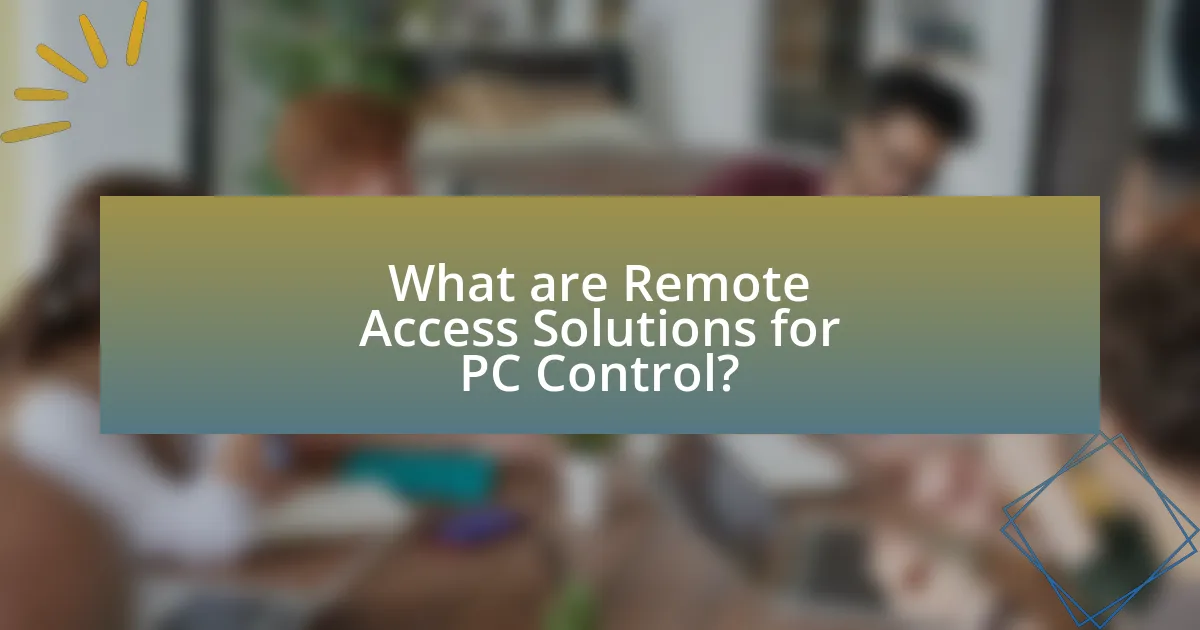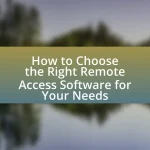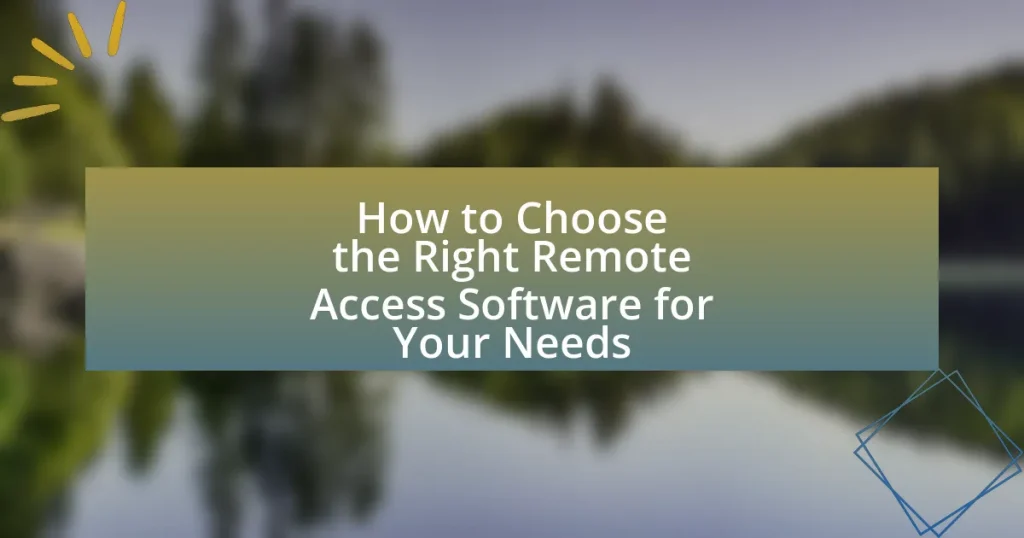Remote access solutions for PC control are software applications that enable users to manage and connect to computers from remote locations, facilitating access to files, applications, and system settings. This article explores the functionality, technologies, and importance of these solutions in today’s digital landscape, highlighting their role in enhancing productivity, flexibility, and security for remote work and collaboration. Key advantages include improved accessibility, efficient troubleshooting, and robust security features that protect sensitive data. Additionally, the article addresses potential challenges and best practices for users to ensure a secure and effective remote access experience.

What are Remote Access Solutions for PC Control?
Remote access solutions for PC control are software applications that enable users to connect to and manage a computer from a remote location. These solutions allow individuals to access files, applications, and system settings as if they were physically present at the computer. Popular examples include TeamViewer, AnyDesk, and Microsoft Remote Desktop, which facilitate remote troubleshooting, file sharing, and collaborative work. The effectiveness of these solutions is supported by their widespread adoption in various industries, enhancing productivity and flexibility for remote work scenarios.
How do Remote Access Solutions function?
Remote access solutions function by establishing a secure connection between a user’s device and a remote computer or network. This connection allows users to control the remote system as if they were physically present, enabling access to files, applications, and resources from anywhere with an internet connection. Technologies such as Virtual Private Networks (VPNs), Remote Desktop Protocol (RDP), and cloud-based services facilitate this process by encrypting data and ensuring secure communication. For instance, according to a report by Gartner, 74% of organizations use remote access solutions to enhance productivity and flexibility, demonstrating their effectiveness in providing seamless access to remote systems.
What technologies enable Remote Access Solutions?
Remote access solutions are enabled by technologies such as Virtual Private Networks (VPNs), Remote Desktop Protocol (RDP), and cloud-based services. VPNs create secure connections over the internet, allowing users to access private networks remotely while maintaining data privacy. RDP, developed by Microsoft, facilitates remote control of a computer over a network connection, enabling users to interact with their desktop as if they were physically present. Cloud-based services, like TeamViewer and AnyDesk, provide platforms for remote access without the need for complex configurations, allowing users to connect to devices from anywhere with internet access. These technologies collectively enhance the ability to manage and control PCs remotely, ensuring secure and efficient access.
How do users connect to remote PCs using these solutions?
Users connect to remote PCs using remote access solutions by establishing a secure connection through software applications that facilitate remote control. These applications, such as TeamViewer, AnyDesk, or Microsoft Remote Desktop, allow users to input the IP address or ID of the remote PC, authenticate with credentials, and gain access to the desktop environment as if they were physically present. The effectiveness of these solutions is supported by their use of encryption protocols, ensuring that data transmitted during the session remains secure and private.
Why are Remote Access Solutions important in today’s digital landscape?
Remote access solutions are crucial in today’s digital landscape because they enable secure and efficient connectivity to devices from any location. This capability supports remote work, allowing employees to access company resources and collaborate effectively, which is essential given that 70% of the workforce is expected to work remotely at least part-time by 2025. Additionally, remote access solutions enhance operational flexibility, reduce overhead costs, and improve productivity by allowing IT support to troubleshoot issues without being physically present. These factors underscore the importance of remote access solutions in facilitating modern business operations and maintaining competitive advantage.
What role do they play in remote work and collaboration?
Remote access solutions play a crucial role in remote work and collaboration by enabling users to connect to their computers and networks from any location. These solutions facilitate seamless communication and collaboration among team members, allowing them to share files, access applications, and troubleshoot issues in real-time, regardless of geographical barriers. For instance, a study by Gartner indicates that 74% of CFOs plan to shift some employees to remote work permanently, highlighting the increasing reliance on such technologies for effective teamwork and productivity.
How do they enhance productivity and efficiency?
Remote access solutions enhance productivity and efficiency by allowing users to access their computers and applications from any location, facilitating seamless work processes. This capability enables employees to work remotely, reducing downtime associated with travel and office constraints. According to a study by Global Workplace Analytics, remote work can increase productivity by 13% due to fewer distractions and a more flexible work environment. Additionally, remote access solutions streamline collaboration by enabling real-time sharing of information and resources, which further accelerates project completion and decision-making.

What are the key advantages of using Remote Access Solutions for PC Control?
The key advantages of using Remote Access Solutions for PC Control include enhanced flexibility, improved productivity, and increased security. Enhanced flexibility allows users to access their PCs from any location, enabling remote work and support. Improved productivity is achieved as users can troubleshoot issues or access files without being physically present, reducing downtime. Increased security is provided through encrypted connections and secure authentication methods, protecting sensitive data during remote sessions. These advantages collectively contribute to more efficient workflows and better resource management in various organizational settings.
How do these solutions improve accessibility?
Remote access solutions improve accessibility by allowing users to connect to their computers from any location, enabling them to access files and applications without being physically present. This capability is particularly beneficial for individuals with mobility challenges, as it eliminates the need for travel to access necessary resources. Additionally, remote access solutions often include features such as screen sharing and remote assistance, which facilitate collaboration and support for users who may require help navigating technology. According to a study by the International Journal of Human-Computer Interaction, remote access tools significantly enhance user engagement and productivity by providing flexible access to computing resources.
What benefits do users gain from accessing their PCs from anywhere?
Users gain significant flexibility and productivity benefits from accessing their PCs from anywhere. This capability allows individuals to work remotely, enabling them to complete tasks and access files regardless of their physical location. For instance, a study by Global Workplace Analytics found that remote work can increase productivity by 13% due to fewer distractions and a more comfortable work environment. Additionally, remote access enhances collaboration, as users can easily share screens and work together in real-time, regardless of geographical barriers. This accessibility also supports better work-life balance, as users can manage personal and professional responsibilities more effectively.
How does remote access facilitate support and troubleshooting?
Remote access facilitates support and troubleshooting by allowing technicians to connect to a user’s device from a different location, enabling real-time assistance. This capability reduces downtime significantly, as issues can be diagnosed and resolved without the need for on-site visits. According to a study by the International Data Corporation, remote support can decrease resolution times by up to 50%, demonstrating its efficiency in addressing technical problems swiftly. Additionally, remote access tools provide technicians with the ability to view and control the user’s screen, making it easier to identify issues and implement solutions directly.
What security features do Remote Access Solutions offer?
Remote Access Solutions offer several key security features, including encryption, multi-factor authentication, and access controls. Encryption protects data transmitted between devices, ensuring that sensitive information remains confidential. Multi-factor authentication adds an extra layer of security by requiring users to verify their identity through multiple methods, reducing the risk of unauthorized access. Access controls allow administrators to define user permissions, ensuring that only authorized personnel can access specific resources. These features collectively enhance the security posture of remote access solutions, making them a reliable choice for secure PC control.
How do these features protect sensitive data during remote sessions?
Remote access solutions protect sensitive data during remote sessions through encryption, access controls, and session monitoring. Encryption secures data in transit, ensuring that any information exchanged between the remote device and the host is unreadable to unauthorized parties. Access controls limit who can connect to the system, requiring authentication measures such as passwords or multi-factor authentication, which significantly reduces the risk of unauthorized access. Additionally, session monitoring allows administrators to track activities during remote sessions, enabling the detection of suspicious behavior and potential data breaches. These combined features create a robust security framework that safeguards sensitive information during remote access.
What measures are in place to prevent unauthorized access?
Measures to prevent unauthorized access include multi-factor authentication, encryption, and access controls. Multi-factor authentication requires users to provide two or more verification factors to gain access, significantly reducing the risk of unauthorized entry. Encryption protects data in transit and at rest, ensuring that even if data is intercepted, it remains unreadable without the proper decryption key. Access controls limit user permissions based on roles, ensuring that individuals can only access information necessary for their tasks. These measures collectively enhance security and protect sensitive information from unauthorized users.

What are the practical applications of Remote Access Solutions?
Remote access solutions enable users to connect to and control computers or networks from a remote location, facilitating various practical applications. These applications include remote technical support, allowing IT professionals to troubleshoot and resolve issues without being physically present; remote work, which enables employees to access company resources and collaborate from anywhere; and remote monitoring, where businesses can oversee systems and networks for performance and security. According to a report by Gartner, 74% of companies plan to permanently shift to more remote work post-pandemic, highlighting the growing reliance on remote access solutions for operational efficiency and flexibility.
How are businesses leveraging Remote Access Solutions?
Businesses are leveraging Remote Access Solutions to enhance productivity and facilitate flexible work arrangements. By utilizing these solutions, organizations enable employees to access their work computers and applications from any location, which has become increasingly vital in the context of remote work trends. According to a report by Gartner, 74% of companies plan to permanently shift to more remote work post-pandemic, highlighting the growing reliance on such technologies. Remote Access Solutions also improve collaboration among teams by allowing seamless sharing of resources and information, thus streamlining workflows and reducing operational delays.
What industries benefit most from these solutions?
The industries that benefit most from remote access solutions for PC control include information technology, healthcare, education, and customer support. In the information technology sector, remote access allows IT professionals to troubleshoot and manage systems efficiently, reducing downtime and improving service delivery. Healthcare organizations utilize remote access to enable telemedicine, allowing healthcare providers to consult with patients remotely, which enhances patient care and accessibility. Educational institutions leverage remote access for online learning, facilitating access to resources and enabling remote teaching. Customer support teams benefit by providing assistance to clients directly on their devices, improving response times and customer satisfaction. These industries demonstrate significant improvements in operational efficiency and service delivery through the use of remote access solutions.
How do Remote Access Solutions support IT management and maintenance?
Remote access solutions support IT management and maintenance by enabling IT professionals to remotely connect to systems and devices, facilitating real-time troubleshooting and updates. This capability allows for immediate response to technical issues, reducing downtime and improving operational efficiency. According to a study by Gartner, organizations that implement remote access solutions can decrease incident resolution times by up to 50%, demonstrating their effectiveness in enhancing IT management processes.
What are the potential challenges of using Remote Access Solutions?
The potential challenges of using Remote Access Solutions include security vulnerabilities, performance issues, and user experience difficulties. Security vulnerabilities arise from unauthorized access and data breaches, as remote access can expose systems to cyber threats if not properly secured. Performance issues may occur due to bandwidth limitations or latency, affecting the responsiveness of applications and overall user experience. Additionally, user experience difficulties can stem from complex interfaces or lack of technical knowledge, leading to inefficient use of the remote access tools. These challenges highlight the need for robust security measures, adequate infrastructure, and user training to mitigate risks associated with remote access solutions.
What common issues do users face when implementing these solutions?
Users commonly face connectivity issues when implementing remote access solutions for PC control. These connectivity problems can arise from unstable internet connections, firewall restrictions, or incorrect network configurations, which hinder the establishment of a reliable remote session. Additionally, users often encounter compatibility issues with different operating systems or software versions, leading to functionality limitations. Security concerns, such as unauthorized access or data breaches, also pose significant challenges, as users must ensure proper authentication and encryption measures are in place. According to a survey by TechRepublic, 30% of IT professionals reported that security vulnerabilities were a major concern when deploying remote access solutions.
How can organizations mitigate risks associated with remote access?
Organizations can mitigate risks associated with remote access by implementing robust security measures such as multi-factor authentication (MFA), encryption, and regular security audits. Multi-factor authentication significantly reduces unauthorized access by requiring users to provide two or more verification factors, making it harder for attackers to gain entry. Encryption protects sensitive data transmitted over remote connections, ensuring that even if data is intercepted, it remains unreadable. Regular security audits help identify vulnerabilities and ensure compliance with security policies, thereby enhancing the overall security posture. According to a report by Cybersecurity & Infrastructure Security Agency, organizations that adopt these measures can reduce the likelihood of data breaches and enhance their resilience against cyber threats.
What best practices should users follow when utilizing Remote Access Solutions?
Users should follow several best practices when utilizing Remote Access Solutions to ensure security and efficiency. First, they should use strong, unique passwords and enable two-factor authentication to protect access credentials. According to a 2021 report by Verizon, 81% of data breaches are linked to weak or stolen passwords, highlighting the importance of robust security measures.
Additionally, users should regularly update their remote access software to patch vulnerabilities, as outdated software can be an easy target for cyberattacks. The Cybersecurity and Infrastructure Security Agency (CISA) emphasizes that keeping software up to date is crucial for maintaining security.
Furthermore, users should limit access to only those who need it and regularly review permissions to prevent unauthorized access. A study by the Ponemon Institute found that 63% of data breaches involve a third party, underscoring the need for strict access controls.
Lastly, users should utilize a Virtual Private Network (VPN) when accessing remote systems to encrypt data transmission, which protects sensitive information from interception. The use of VPNs is recommended by the National Institute of Standards and Technology (NIST) as a best practice for secure remote access.
How can users ensure a secure and efficient remote access experience?
Users can ensure a secure and efficient remote access experience by implementing strong authentication methods, utilizing a Virtual Private Network (VPN), and keeping software updated. Strong authentication methods, such as multi-factor authentication, significantly reduce the risk of unauthorized access, as they require multiple forms of verification. A VPN encrypts data transmitted over the internet, protecting sensitive information from potential interception. Regularly updating software, including remote access applications and operating systems, addresses security vulnerabilities and enhances performance. According to a report by Cybersecurity Ventures, organizations that employ multi-factor authentication can reduce the risk of breaches by up to 99.9%.
What tips can enhance the effectiveness of Remote Access Solutions?
To enhance the effectiveness of Remote Access Solutions, implement strong security measures, such as using multi-factor authentication and encryption. These practices protect sensitive data and prevent unauthorized access, which is crucial given that a report by Cybersecurity Ventures predicts that cybercrime will cost the world $10.5 trillion annually by 2025. Additionally, ensuring a stable internet connection improves performance and user experience, as latency issues can hinder productivity. Regularly updating software and systems also mitigates vulnerabilities, as outdated software is a common target for cyberattacks. Lastly, providing user training on best practices can significantly reduce human error, which is responsible for 95% of cybersecurity breaches according to a study by the University of Maryland.





